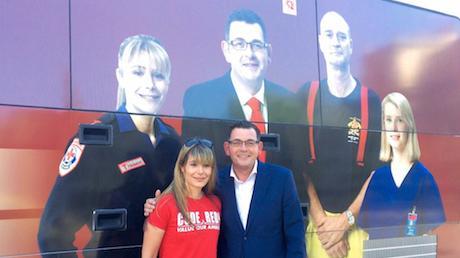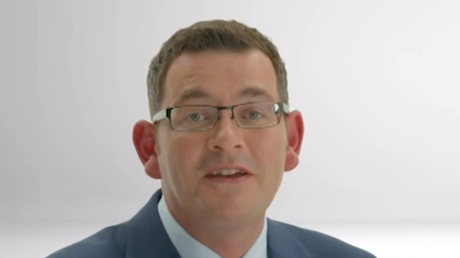
Spring. The season of champagne, racing silks, roses, crowded racetracks, fillies, frocks, punters, celebrities and …. politicians?
It might be like mixing oil and water but since Victoria adopted four-year fixed term elections in 2003, the carnival season has become part of the tough media terrain Victorian politicians on the hustings must master. In the galloping news cycle, and given general public disaffection for party politics, it is difficult enough for politicians to cut through with their political messages without having to compete for air play with an Irish colt named Adelaide.
The spring racing carnival helps explain why Victorian Labor was first out of the gates with its official campaign launch in Geelong yesterday, a week before the issuing of the election writs – on Melbourne Cup day – marking the beginning of the official election period.
Unlike federal elections which are a longer race with a minimum of 33 days, the official Victorian state election period runs the shorter distance of 25 days. But with cartoonists referring to the Opposition leader as Andrew Daniels, and a Swinburne University poll of 206 last week finding almost two-thirds of enrolled voters could not identify the would-be Premier in a photograph (see here), it is no surprise that the Labor Party decided to launch early.
Recognition matters in politics. Daniel Andrews’ early launch is designed to maximise the Opposition leader’s profile and grab some headlines before the news pages shift to style and punting tips for the race that stops a nation. It also enables Labor to set the campaign agenda with its centrepiece message on Sunday, the ‘Education State’, and promises of a $1.3 billion education package.
Geelong is an obvious choice for the Labor launch. Victoria’s unemployment rate is 6.7 per cent, above the national average of 6.0 per cent, but in Geelong, it is much higher at 9.2 per cent. Double this number and you have Geelong’s youth unemployment rate at 18.4 per cent. These figures tell the story of how Geelong has been disproportionately hit by a string of high-profile manufacturing closure announcements including at Ford, Target, Avalon and Alcoa. Rising unemployment in marginal seats is political dynamite. Labor’s weekend launch draws attention to the marginal electorates around Geelong, important because the Opposition needs a net gain of five seats to win office with a uniform swing of 0.9 per cent.
For the punter, predicting the outcome of the 2014 state election requires factoring in some unique and complicating details. A 2013 electoral boundary redistribution resulted in the Liberal and Nationals losing a seat each, replaced by two safe Labor seats in Melbourne’s west. Other boundary changes have led to five Labor-held seats becoming notionally Liberal seats.
However, the Napthine government has no easy ride. Five of the Liberal Party’s eight most marginal seats are occupied by Labor MPs. This creates the unusual situation where the incumbent government does not have the advantage of incumbency (for full details see Antony Green’s analysis here).
Again this brings us back to Geelong. The seat of Bellarine, held by Labor MP Lisa Neville in 2010 with a 1.4 per cent margin, on the new boundaries becomes a notional Liberal seat with a 2.5 per cent margin. But, the Labor margin in Geelong shifts in the ALP’s favour under the redistribution from a 2.1 per cent buffer to 4.0 per cent; however, the sitting member is retiring and ALP candidate, Christine Couzens, a former ALP staffer, replaces him.
South Barwon, another marginal seat, was lost by Labor at the 2010 election and is a liberal-held seat by Andrew Katos with a post-distribution margin of 4.9 per cent.
When picking a winner, there are also the opinion polls to consider. Labor has dominated the Victorian polls since the election of the federal Liberal Government in September 2013. Typically, voters do discriminate between federal and state issues. Nonetheless, at the ALP’s state launch, federal Opposition leader Bill Shorten did all he could to blur the policy boundaries between the two electoral spheres slamming Joe Hockey, Christopher Pyne and Scott Morrison in his opening remarks to introduce Daniel Andrews.
But if we trust the polls, the ALP is on track to win the electoral race. Today’s Galaxy/Herald-sun poll has the ALP with a 52-48 per cent two-party preferred lead over the Coalition, despite Daniel Andrews remaining a long way behind Dr Napthine as preferred Premier.
Then there is the key 2014 election issue of transport. This is one policy area where the two major parties are clearly divided. While both parties have committed to major infrastructure spending to tackle Victoria’s growing population, there is bitter tension about how to best ease traffic congestion. The meltdown of road and rail systems in this morning’s deluge exposed the vulnerability of the stressed networks, disrupting train timetabling, overloading major roads, and stoking commuter aggravation to fever pitch on talkback and social media.
The Napthine Government has signed contracts to build the first stage of the $8 billion East West Link, featuring nearly seven kilometres of a cross city road including underground tunnels.
Daniel Andrews, mindful of being wedged on the issue in a handful of inner city electorates that at the last election earned the Greens primary votes above 30 per cent (Brunswick, Melbourne, Richmond and Northcote), has pledged to tear up the contracts and focus instead on the Melbourne Metro Rail project. This features a nine kilometre train tunnel linking the Sunbury and Pakenham-Dandenong lines and building five new underground stations and promises to remove dangerous level crossings. The Coalition has also pledged two new rail stations and the Melbourne Airport Rail link connecting Tullamarine airport to Southern Cross Station.
With the exception of the electorate of Morwell, which has a sizeable margin of 13.3 per cent, but is in danger of being lost by the Nationals after the poor handling of the Hazelwood coal mine fire, the 2014 election battleground is the state’s marginal seats. These will determine which of the magnificent competitive creatures — Dr Denis Napthine or Daniel Andrews — enters the winner’s circle on 29 November.
Andrea Carson is a lecturer in media and politics at the University of Melbourne.




